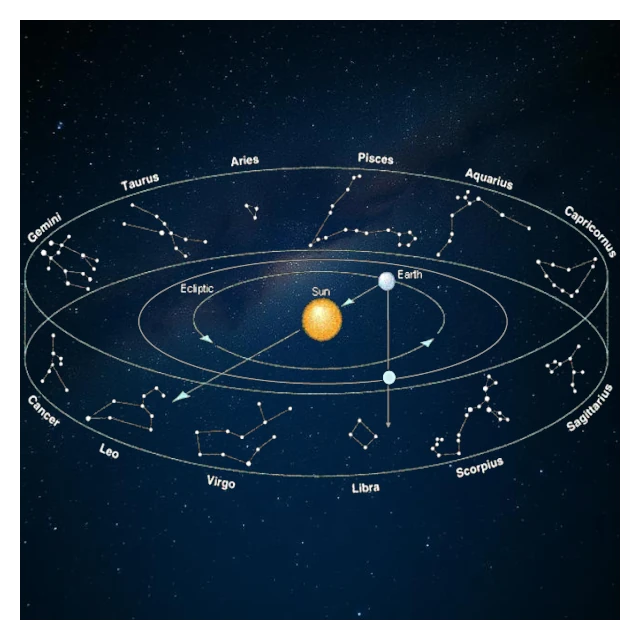
The zodiac corresponds to a celestial band of about 8.5° on either side of the ecliptic. This region of the sky contains the constellations crossed by the Sun during its apparent annual motion. In other words, the zodiac is not a purely symbolic invention, but a geometric consequence of the Earth's rotation and the tilt of its axis.
The twelve zodiac constellations, from Aries to Pisces, are defined by their position in this celestial band. Ancient Mesopotamian, Egyptian, and then Greek astronomers divided this circle into twelve equal sectors of 30°, corresponding to a full cycle of 360°, or one solar year.
The first traces of the division of the sky into zodiacal sectors date back to Mesopotamia around 2000 BC. Babylonian priest-astronomers, observing the movements of the Sun, Moon, and planets, identified a recurring set of constellations along this path. The adoption of twelve segments was probably linked to the lunar cycle (≈ 12 lunations per year).
It was then the great Greek astronomer Claudius Ptolemy (c. 100-170) who fixed the positions of the zodiac constellations in his major work, the Almagest. He also associated the notions of right ascension and declination, laying the foundations for modern celestial cartography.
N.B.:
Right ascension and declination are the two coordinates of the equatorial celestial reference system. Right ascension, analogous to terrestrial longitude, is measured in hours, minutes, and seconds of angle eastward from the vernal equinox, while declination is measured in degrees north or south of the celestial equator. They allow the precise positioning of a star on the celestial sphere. The vernal equinox is the point of intersection between the plane of the ecliptic and the plane of the celestial equator, corresponding to the position of the Sun when it moves from the southern celestial hemisphere to the northern celestial hemisphere at the time of the spring equinox.
Unlike astrological signs, the zodiac constellations are of unequal sizes and no longer correspond to the traditional horoscope dates. Due to the precession of the equinoxes, the Sun no longer enters the constellations at the same times as it did two millennia ago.
N.B.:
The International Astronomical Union (IAU) officially recognizes thirteen constellations crossed by the Sun, including Ophiuchus, between Scorpio and Sagittarius.
The following table illustrates the differences between the symbolic dates of the astrological signs and the actual positions of the Sun in the corresponding constellations, according to NASA data (2023).
| Constellation | Astrological Dates | Actual Sun Dates | Comment |
|---|---|---|---|
| Aries (Aries) | March 21 - April 19 | April 19 - May 13 | Shift due to precession |
| Taurus (Taurus) | April 20 - May 20 | May 14 - June 21 | Constellation longer than the astrological sign |
| Gemini (Gemini) | May 21 - June 20 | June 21 - July 20 | The Sun stays there for about 30 days |
| Cancer (Cancer) | June 21 - July 22 | July 21 - August 10 | Relatively short constellation |
| Leo (Leo) | July 23 - August 22 | August 11 - September 16 | The Sun crosses this constellation for about 36 days |
| Virgo (Virgo) | August 23 - September 22 | September 17 - October 30 | Large zodiac constellation |
| Libra (Libra) | September 23 - October 22 | October 31 - November 22 | Relatively small constellation |
| Scorpio (Scorpius) | October 23 - November 21 | November 23 - November 29 | Very short crossing, about 7 days |
| Ophiuchus (Ophiuchus) | (not included) | November 30 - December 17 | Often ignored in astrology, but real astronomically |
| Sagittarius (Sagittarius) | November 22 - December 21 | December 18 - January 18 | Large constellation, rich in clusters and nebulae |
| Capricorn (Capricornus) | December 22 - January 19 | January 19 - February 15 | Triangular constellation, symbol of the sea-goat |
| Aquarius (Aquarius) | January 20 - February 18 | February 16 - March 11 | Diffuse constellation, symbolizing water |
| Pisces (Pisces) | February 19 - March 20 | March 12 - April 18 | The Sun stays there for about a month |
Source: NASA – Solar System Exploration and International Astronomical Union (IAU).
The zodiac constellations have served as landmarks for navigation, agriculture, and timekeeping. The Egyptians, around 1000 BC, oriented their temples according to the heliacal risings of the zodiac stars. The Greeks, with Hipparchus of Nicaea (c. 190-120 BC), discovered the precession of the equinoxes, explaining the slow drift of the constellations across the celestial sphere. Today, these stellar figures remain a fundamental reference for astronomers and astrophysicists in the study of celestial dynamics.
The zodiac constellations constitute an ancient but still relevant mapping of our sky. They materialize the path of the Sun, Moon, and planets against the starry background, offering a direct link between astronomical observation and human symbolism. Between celestial geometry and cultural heritage, the zodiac remains a witness to our way of reading the sky and understanding our place in the cosmos.